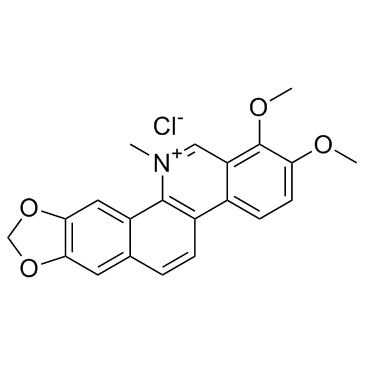Chelerythrine chloride

Chelerythrine chloride structure
|
Common Name | Chelerythrine chloride | ||
|---|---|---|---|---|
| CAS Number | 3895-92-9 | Molecular Weight | 383.825 | |
| Density | 1.36g/cm3 | Boiling Point | 711.4ºC at 760 mmHg | |
| Molecular Formula | C21H18ClNO4 | Melting Point | 195-205ºC | |
| MSDS | Chinese USA | Flash Point | 219.3ºC | |
| Symbol |

GHS07 |
Signal Word | Warning | |
|
Calcitonin controls bone formation by inhibiting the release of sphingosine 1-phosphate from osteoclasts.
Nat. Commun. 5 , 5215, (2014) The hormone calcitonin (CT) is primarily known for its pharmacologic action as an inhibitor of bone resorption, yet CT-deficient mice display increased bone formation. These findings raised the question about the underlying cellular and molecular mechanism of... |
|
|
Cross-talk between alpha1D-adrenoceptors and transient receptor potential vanilloid type 1 triggers prostate cancer cell proliferation.
BMC Cancer 14 , 921, (2014) There is evidence that calcium (Ca(2+)) increases the proliferation of human advanced prostate cancer (PCa) cells but the ion channels involved are not fully understood. Here, we investigated the correlation between alpha(1D)-adrenergic receptor (alpha(1D)-AR... |
|
|
Group I metabotropic glutamate receptor-mediated activation of PKC gamma in the nucleus accumbens core promotes the reinstatement of cocaine seeking.
Addict. Biol. 20(2) , 285-96, (2015) Emerging evidence indicates that type I metabotropic glutamate receptors (mGluRs) in the nucleus accumbens play a critical role in cocaine seeking. The present study sought to determine the role of accumbens core mGluR1, mGluR5 and protein kinase C (PKC) in c... |
|
|
Neuronal somata and extrasomal compartments play distinct roles during synapse formation between Lymnaea neurons.
J. Neurosci. 34(34) , 11304-15, (2014) Proper synapse formation is pivotal for all nervous system functions. However, the precise mechanisms remain elusive. Moreover, compared with the neuromuscular junction, steps regulating the synaptogenic program at central cholinergic synapses remain poorly d... |
|
|
Juvenile hormone prevents 20-hydroxyecdysone-induced metamorphosis by regulating the phosphorylation of a newly identified broad protein.
J. Biol. Chem. 289(38) , 26630-41, (2014) The steroid hormone 20-hydroxyecdysone (20E) initiates insect molting and metamorphosis. By contrast, juvenile hormone (JH) prevents metamorphosis. However, the mechanism by which JH inhibits metamorphosis remains unclear. In this study, we propose that JH in... |
|
|
Neuronal K(ATP) channels mediate hypoxic preconditioning and reduce subsequent neonatal hypoxic-ischemic brain injury.
Exp. Neurol. 263 , 161-71, (2014) Neonatal hypoxic-ischemic brain injury and its related illness hypoxic-ischemic encephalopathy (HIE) are major causes of nervous system damage and neurological morbidity in children. Hypoxic preconditioning (HPC) is known to be neuroprotective in cerebral isc... |
|
|
A functional coupling between extrasynaptic NMDA receptors and A-type K+ channels under astrocyte control regulates hypothalamic neurosecretory neuronal activity.
J. Physiol. 592(Pt 13) , 2813-27, (2014) Neuronal activity is controlled by a fine-tuned balance between intrinsic properties and extrinsic synaptic inputs. Moreover, neighbouring astrocytes are now recognized to influence a wide spectrum of neuronal functions. Yet, how these three key factors act i... |
|
|
Involvement of basal and calcium-activated protein kinase C in neurotransmitter secretion in mouse motor synapses.
Bull. Exp. Biol. Med. 153(6) , 820-3, (2012) Blocker of presynaptic protein kinase C isoforms, GF109203X, reduced quantal content of single and rhythmic evoked end-plate potentials. The increase in quantal content of single potentials under the effect of 4- aminopyridine was neutralized by 75% under the... |
|
|
High-throughput drug screen identifies chelerythrine as a selective inducer of death in a TSC2-null setting.
Mol. Cancer Res. 13(1) , 50-62, (2015) Tuberous sclerosis complex (TSC) is an autosomal dominant syndrome associated with tumors of the brain, heart, kidney, and lung. The TSC protein complex inhibits the mammalian or mechanistic target of rapamycin complex 1 (mTORC1). Inhibitors of mTORC1, includ... |
|
|
The Signaling Mechanism of Contraction Induced by ATP and UTP in Feline Esophageal Smooth Muscle Cells.
Mol. Cells 38 , 616-23, (2015) P2 receptors are membrane-bound receptors for extracellular nucleotides such as ATP and UTP. P2 receptors have been classified as ligand-gated ion channels or P2X receptors and G protein-coupled P2Y receptors. Recently, purinergic signaling has begun to attra... |